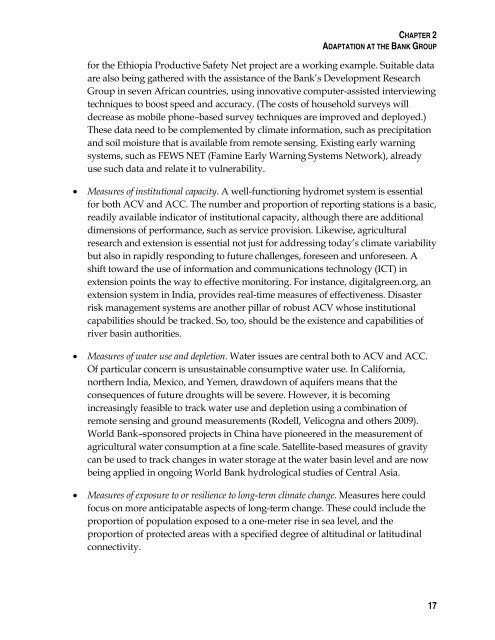Adapting to Climate Change: Assessing the World Bank Group ...
Adapting to Climate Change: Assessing the World Bank Group ...
Adapting to Climate Change: Assessing the World Bank Group ...
You also want an ePaper? Increase the reach of your titles
YUMPU automatically turns print PDFs into web optimized ePapers that Google loves.
CHAPTER 2ADAPTATION AT THE BANK GROUPfor <strong>the</strong> Ethiopia Productive Safety Net project are a working example. Suitable dataare also being ga<strong>the</strong>red with <strong>the</strong> assistance of <strong>the</strong> <strong>Bank</strong>’s Development Research<strong>Group</strong> in seven African countries, using innovative computer-assisted interviewingtechniques <strong>to</strong> boost speed and accuracy. (The costs of household surveys willdecrease as mobile phone–based survey techniques are improved and deployed.)These data need <strong>to</strong> be complemented by climate information, such as precipitationand soil moisture that is available from remote sensing. Existing early warningsystems, such as FEWS NET (Famine Early Warning Systems Network), alreadyuse such data and relate it <strong>to</strong> vulnerability.Measures of institutional capacity. A well-functioning hydromet system is essentialfor both ACV and ACC. The number and proportion of reporting stations is a basic,readily available indica<strong>to</strong>r of institutional capacity, although <strong>the</strong>re are additionaldimensions of performance, such as service provision. Likewise, agriculturalresearch and extension is essential not just for addressing <strong>to</strong>day’s climate variabilitybut also in rapidly responding <strong>to</strong> future challenges, foreseen and unforeseen. Ashift <strong>to</strong>ward <strong>the</strong> use of information and communications technology (ICT) inextension points <strong>the</strong> way <strong>to</strong> effective moni<strong>to</strong>ring. For instance, digitalgreen.org, anextension system in India, provides real-time measures of effectiveness. Disasterrisk management systems are ano<strong>the</strong>r pillar of robust ACV whose institutionalcapabilities should be tracked. So, <strong>to</strong>o, should be <strong>the</strong> existence and capabilities ofriver basin authorities.Measures of water use and depletion. Water issues are central both <strong>to</strong> ACV and ACC.Of particular concern is unsustainable consumptive water use. In California,nor<strong>the</strong>rn India, Mexico, and Yemen, drawdown of aquifers means that <strong>the</strong>consequences of future droughts will be severe. However, it is becomingincreasingly feasible <strong>to</strong> track water use and depletion using a combination ofremote sensing and ground measurements (Rodell, Velicogna and o<strong>the</strong>rs 2009).<strong>World</strong> <strong>Bank</strong>–sponsored projects in China have pioneered in <strong>the</strong> measurement ofagricultural water consumption at a fine scale. Satellite-based measures of gravitycan be used <strong>to</strong> track changes in water s<strong>to</strong>rage at <strong>the</strong> water basin level and are nowbeing applied in ongoing <strong>World</strong> <strong>Bank</strong> hydrological studies of Central Asia.Measures of exposure <strong>to</strong> or resilience <strong>to</strong> long-term climate change. Measures here couldfocus on more anticipatable aspects of long-term change. These could include <strong>the</strong>proportion of population exposed <strong>to</strong> a one-meter rise in sea level, and <strong>the</strong>proportion of protected areas with a specified degree of altitudinal or latitudinalconnectivity.17

















